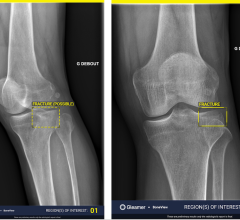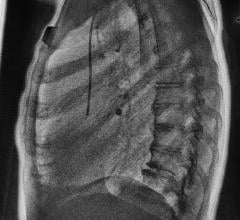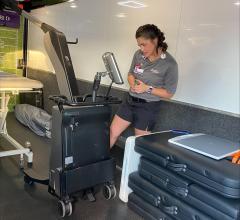Roland Rhynus, CRA, executive director of radiology
X-rays are one of the most frequently used technologies within the radiology department of any hospital. X-ray has become a staple technology for the diagnosis of many conditions due to its non-invasive ability to easily and quickly view internal injuries. It is no wonder that this technology has undergone a path of major evolution over the past few decades. X-ray technology has advanced from film that had to be developed with chemicals before it could be viewed, to computed radiography (CR) that utilizes a cassette containing an imaging plate processed through a special laser scanner, or a CR reader that digitizes the image to be viewed on a computer, to direct radiography (DR), considered to be the most advanced radiography technology available today.
Instead of X-ray film or cassettes, DR technology utilizes a digital image capture device that provides instant image review and eliminates the need for any processing time. DR images are available for review immediately, within seconds of the image being taken. The benefits of having a digital system are numerous. The instant availability of images for review increases workflow efficiency within the radiology department and results in significant time savings and consequently, significant cost savings. Among the advantages of DR are the elimination of costly film processing steps; potential for radiation dose reduction, a wider dynamic range, which makes it more forgiving for over- and under-exposure; and the ability to apply special image processing techniques that enhance overall display of the image.
The diagnostic radiology department of LLUMC conducts an average of 500 diagnostic exams for roughly 1,600 images per day. It was clear that transitioning from CR to DR would have significant positive impact on patient care. However, without the availability of sufficient capital to fund this transition, moving to DR did not appear to be a current possibility, but instead it would need to be a future goal. The radiology department was left with the challenge of trying to find a way to implement a DR an upgrade that they knew would save the hospital vast amounts of money in the long-run without the availability of a large up-front capital investment to purchase and install the new equipment.
LLUMC turned to Agfa HealthCare to find a solution to this major challenge. The answer came in the form of Agfa HealthCare’s Fast Forward DR Upgrade Program, which was designed to allow hospitals to keep up with the fast-paced evolution in X-ray technology even in the absence of immediate capital funds. The program allows healthcare providers to sustain their existing financial model and upgrade to the best X-ray technology available with a cost structure that allows the transition to pay for itself.
Unique Cost Structure Makes DR Upgrade Possible
Agfa HealthCare’s Fast Forward program made it possible for LLUMC to proactively upgrade its X-ray technologies to DR despite their lack of immediate capital to pay for the upgrade. The program features a unique cost structure in which LLUMC pays fixed monthly payments over a 60-month period in lieu of dedicating a large amount of capital to the upgrade immediately.
The monthly payments incurred by the program are marginally higher than the cost the hospital currently pays for the monthly maintenance of its CR technologies. As a result, the transition “pays for itself” by allowing the hospital to reallocate operational cost savings achieved by using cassette-less DR technology to cover the marginal increase in monthly payments.
“What made the DR upgrade a no-brainer for us was the marginal cost increase in monthly payments for the adoption of significantly superior DR technology as compared to what we were paying previously for ongoing maintenance of our CR technologies,” said Roland Rhynus, CRA, executive director of radiology. “The minor cost increase has resulted in major realizations in staff efficiency, patient comfort and satisfaction, time savings and X-ray image quality.”
The main benefit of the Fast Forward DR Upgrade Program is to obtain the latest and most advanced DR X-ray technologies in a cost effective manner. The bonus is that the program also includes a service maintenance agreement (SMA) for ongoing maintenance support and a Damage Assistance Program (DAsP), which provides insurance for the costly DR plates as part of the monthly payment. Mike Haman, enterprise director imaging informatics commented, “These are expenses that a hospital would normally pay for on top of the purchase and installation costs of new equipment. Having them included in the cost of the program makes the upgrade especially cost effective.”
Upgrading Existing CR Technologies Instead of Replacing
Agfa HealthCare’s DX-D Retrofit is the heart of the upgrade program. The DX-D Retrofit provides healthcare facilities using analog or CR technology an efficient upgrade to the benefits of DR without replacing their existing X-ray equipment. By maximizing the use of existing equipment while simplifying installation, DX-D Retrofit provides an easy and affordable way to implement direct digital image capture in the X-ray room that can then be shared and accessed within the EHR. This vendor-neutral upgrade solution provides DR workflow and image quality for a fraction of the price of a complete system and handles many applications throughout multiple hospital departments.
By upgrading existing CR equipment to DR instead of completely replacing the CR equipment, LLUMC attained significant cost savings. A typical X-ray room replacement would not only require the cost to purchase DR equipment, but would also require construction and installation costs.
In addition to LLUMC’s installation of 11 DX-D Retrofits, five wireless DX-D 100 mobile DR systems were installed to allow for DR images to be taken and reviewed at the patient’s bedside. The DX-D 100 connects wirelessly to the hospital information system and contains onboard dose management tools, allowing for instant high-quality image capture at the patient bedside to facilitate improved patient comfort and reduce radiation dose. It also features smaller format detector technology to aid with NICU incubator imaging, pediatric, and orthopaedic applications.
Real Benefits of DR Upgrade at LLUMC
Streamlined workflow and time savings. Although typically it only takes a few minutes to develop a CR X-ray cassette, collective processing time becomes substantial when it is multiplied by the hundreds of X-rays LLUMC conducts every day. The automatic digital downloading of images with DR technology, combined with faster exams, has saved the radiology staff significant time, which also translates into cost savings at the hospital.
Prior to LLUMC’s DR upgrade, X-ray technologists had to bring the cassette to a CR processing room to process the image. These CR processing rooms could be located down the hall or floors away from the patient. After processing was complete, the technologist would then have to send the image to the PACS system and wait for the health care team to log into the PACS to view the image.
During a typical day an X-ray technologist will save an average of 8 minutes and 10 seconds per image by utilizing Agfa HealthCare’s DR technology instead of CR. LLUMC has also been able to reduce the number of X-ray technologists needed to conduct certain exams from two radiographers with CR to only one radiographer with DR – gaining 100 percent staff efficiency. When that time savings and staff reduction is multiplied by the volume of X-rays conducted daily, the cost savings are significant. With Agfa HealthCare’s DR technology, each minute is used to the fullest in delivering patient care.
Better image quality and radiation dose reduction. Agfa HealthCare’s patented MUSICA image processing software is utilized with the entire DR product line and was automatically installed with all of LLUMC’s DR technologies. MUSICA brings multi-scaled image processing to a new level by showing exquisite detail in low noise images that allows radiologists at LLUMC to consistently capture high-quality images at lower radiation dose when the needle-based detector option is used.
Images processed with DR technologies using MUSICA show more detail. This allows radiologists to modify their techniques by increasing the kilovoltage (kVp) and decreasing the milliampere seconds (mAs), thus lowering the effective radiation dose. With Agfa HealthCare’s DR systems using the needle-based detector option, the radiation exposure to the patient can be reduced by at least one third without any noticeable difference in image quality.
DR technologies are able to produce quality images at a lower exposure index (EI) than is needed to achieve the same quality image with CR technologies. A quality image can be achieved even though the EI may indicate that the technique selected is “underexposing.” MUSICA allows the contrast and brightness of an image to be adjusted directly after it has been taken. This allows an image with a lower EI taken with DR to be as diagnostic as one with an EI within mid-range taken with CR.
Optimized patient comfort and care. Patient engagement, comfort, and satisfaction at LLUMC have greatly increased as a result of the upgrade to DR. Agfa HealthCare’s DR technologies allow the technologist to view the X-ray image seconds after the exposure is made while still with the patient. This allows the technologist to immediately verify that a high quality radiograph is obtained and any necessary adjustments can be made quickly if an additional image is required.
If any additional views or modifications are needed, the patient is able to stay in their current position while the image is retaken, as the DR image plate does not have to be replaced after each exposure, as is required with CR plates. Furthermore, no matter where the body part of interest is placed on the DR detector, the image is automatically centered after the exposure is made. This is especially beneficial when imaging the small extremities of pediatric patients that are positioned on the edges or corners of the detector.
“For bed-ridden trauma patients and children in particular, the ability to immediately review an image and retake it right then and there, if necessary, is a huge positive. To force a bed-ridden trauma patient in pain or an active child to redo the entire X-ray process can be very difficult. We’re now able to avoid those unnecessary and uncomfortable image retakes. We’re also able to take action immediately if the X-ray image indicates further medical procedures are needed.” said Aimee Gallegos, R.T. interim manager Children’s Hospital radiology.
DR Advantages: By the Numbers
67% more exams per day for increased productivity
8.16 minutes time savings on average, per exam
9 more patients per day; 3,285 more per year
100% FTE (full-time equivalent) gain by reducing the number of technologists required per exam from two to one
Conclusion
With Agfa HealthCare’s Fast Forward DR Upgrade Program, LLUMC was able to upgrade its X-ray technologies to a completely digital system.
The Fast Forward DR Upgrade Program allows health systems to upgrade to DR without dedicating capital funds to the project. Obtaining X-rays at LLUMC is now a faster and easier process. Agfa HealthCare’s DR solutions have provided LLUMC a more efficient workflow, better image quality and the potential to reduce radiation dose.
“As our technologists become more comfortable with our new DR systems, we expect time savings to increase. Without this program we undoubtedly would not have been able to make the transition to DR in the short time that we have,” summarized R. Todd Thall, R.T. chief technologist diagnostic radiology.
The monthly payments for the DR upgrade program are only marginally higher than the monthly maintenance fees of CR technology, providing a unique cost structure that pays for itself over time. More efficient X-ray procedures, which require less time and less staff resources to complete, result in cost savings for the health system that will last long after their DR payments are completed. With this innovative cost structure, Agfa HealthCare helps its customers keep up with the ever-changing evolution of healthcare and give their patients the best technologies available.
For more information: www.agfahealthcare.com



 December 10, 2025
December 10, 2025 








